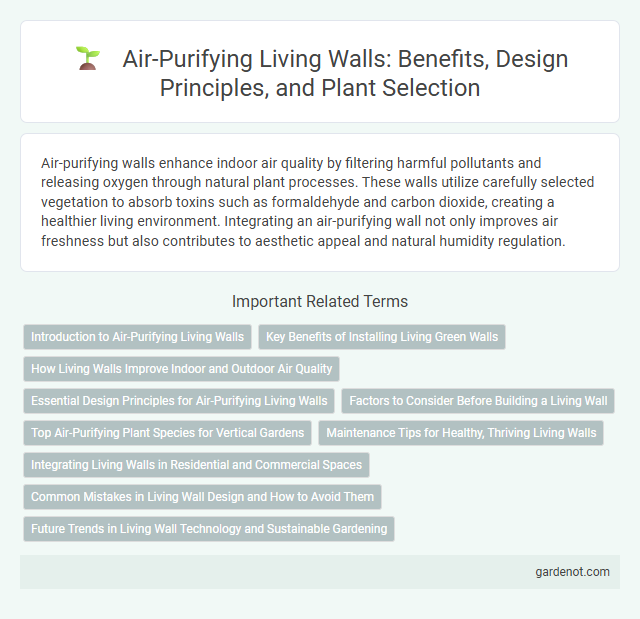Air-purifying walls enhance indoor air quality by filtering harmful pollutants and releasing oxygen through natural plant processes. These walls utilize carefully selected vegetation to absorb toxins such as formaldehyde and carbon dioxide, creating a healthier living environment. Integrating an air-purifying wall not only improves air freshness but also contributes to aesthetic appeal and natural humidity regulation.
Introduction to Air-Purifying Living Walls
Air-purifying living walls consist of vertical structures densely planted with a variety of foliage that naturally filter indoor and outdoor air pollutants. These biofilters effectively reduce carbon dioxide, volatile organic compounds (VOCs), and particulate matter, improving air quality in urban and indoor environments. Incorporating species like English ivy, spider plants, and peace lilies enhances the effectiveness of these green walls in promoting healthier living spaces.
Key Benefits of Installing Living Green Walls
Living green walls significantly improve indoor air quality by filtering harmful pollutants and increasing oxygen levels, creating a healthier environment. These air-purifying walls reduce airborne toxins such as formaldehyde, benzene, and carbon dioxide, enhancing respiratory health and overall wellbeing. Incorporating living walls also helps regulate indoor humidity, reducing mold growth and contributing to sustainable building practices.
How Living Walls Improve Indoor and Outdoor Air Quality
Living walls, also known as green walls, significantly enhance air quality by filtering pollutants and increasing oxygen levels through photosynthesis. These vertical gardens trap airborne toxins, particulate matter, and carbon dioxide, effectively reducing indoor and outdoor air pollution. By promoting natural airflow and humidity balance, living walls contribute to healthier, fresher environments in urban areas and enclosed spaces.
Essential Design Principles for Air-Purifying Living Walls
Air-purifying living walls optimize indoor air quality by incorporating plants like spider plants, snake plants, and pothos known for high pollutant absorption. Essential design principles include ensuring adequate plant density, proper irrigation systems, and selecting species with high transpiration rates to maximize air filtration. Integrating activated carbon substrates and maintaining balanced humidity levels further enhance the wall's effectiveness in reducing volatile organic compounds (VOCs) and airborne toxins.
Factors to Consider Before Building a Living Wall
Selecting the right plant species with proven air-purifying capabilities is crucial for maximizing a living wall's effectiveness in improving indoor air quality. Proper irrigation systems and adequate lighting conditions must be assessed to ensure plant health and sustained air filtration performance. Structural support and maintenance accessibility also influence the longevity and functional benefits of an air-purifying living wall.
Top Air-Purifying Plant Species for Vertical Gardens
Spider plants (Chlorophytum comosum), snake plants (Sansevieria trifasciata), and pothos (Epipremnum aureum) rank among the top air-purifying plants for living walls due to their exceptional ability to remove formaldehyde, benzene, and carbon monoxide from indoor air. These species thrive in vertical garden setups, offering high foliage density and low maintenance requirements, which enhances natural air filtration in homes and offices. Incorporating peace lilies (Spathiphyllum) and Boston ferns (Nephrolepis exaltata) further boosts the air-cleaning efficiency by targeting additional airborne toxins like ammonia and xylene.
Maintenance Tips for Healthy, Thriving Living Walls
Regularly trim and prune air-purifying living walls to prevent overgrowth and encourage healthy foliage development. Ensure consistent watering schedules tailored to the specific plant species, avoiding waterlogging to prevent root rot. Monitor for pests and diseases frequently, applying organic treatments promptly to maintain optimal air purification and plant vitality.
Integrating Living Walls in Residential and Commercial Spaces
Living walls harness the natural air-purifying abilities of plants, significantly reducing indoor pollutants like VOCs and improving overall air quality in both residential and commercial environments. Integrating air-purifying walls into building designs enhances oxygen production, regulates indoor humidity, and promotes healthier living and working spaces. Strategic placement and selection of plant species ensure maximum efficiency in filtering airborne toxins, creating sustainable and aesthetically pleasing environments.
Common Mistakes in Living Wall Design and How to Avoid Them
Common mistakes in living wall design include improper plant selection, inadequate irrigation systems, and neglecting structural support, which can lead to plant stress and system failure. Choosing air-purifying plants suited for indoor environments, implementing automated drip irrigation, and reinforcing wall mounts ensure longevity and optimal air quality benefits. Regular maintenance and monitoring also prevent mold growth and nutrient deficiencies, maximizing the efficiency of the air-purifying living wall.
Future Trends in Living Wall Technology and Sustainable Gardening
Future trends in living wall technology emphasize advanced air-purifying systems using bio-filtration and smart sensors that optimize plant health and indoor air quality. Integration of sustainable gardening practices incorporates drought-resistant and native plant species, reducing water consumption while enhancing carbon sequestration. Innovations in modular designs and IoT connectivity enable more efficient maintenance and adaptive environmental control for urban green spaces.
Air-purifying wall Infographic

 gardenot.com
gardenot.com